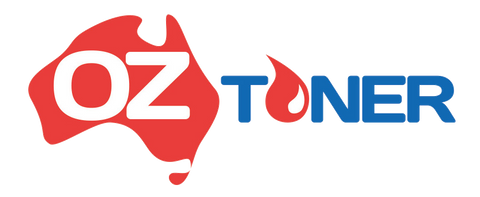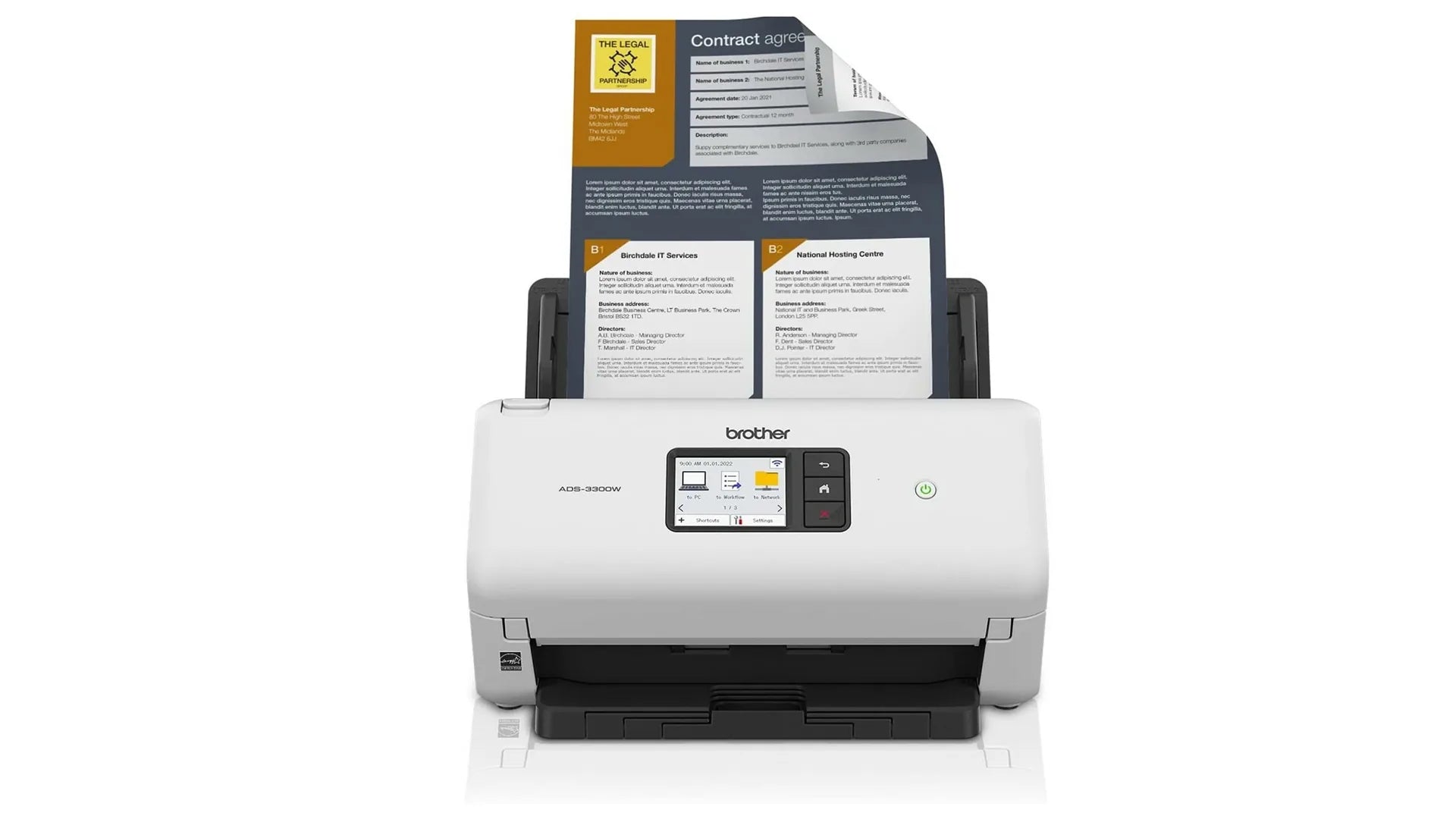Excellence has become table stakes for desktop document scanners
-
PROS
- Faster than rated scanning speeds
- Accurate OCR
- Decent document archiving features
- Scans to USB storage devices without a PC
- Three-year warranty
-
CONS
- Lacks comprehensive Mac support
BROTHER ADS-3300W WIRELESS HIGH-SPEED DESKTOP SCANNER SPECS
| Automatic Document Feeder | |
| Ethernet Interface | |
| Film Scanning | |
| Flatbed | |
| Maximum Optical Resolution | 600 pixels |
| Maximum Scan Area | 8.5" x 196.8" |
| Mechanical Resolution | 1200 |
Think we've reviewed a lot of Brother desktop document scanners lately? You're not imaging it: The company recently released five sheetfed models, including the ADS-4300N, the ADS-4700W, and the ADS-4900W, which copped an Editors' Choice award among high-volume networkable scanners. Today's entry, the ADS-3300W Wireless High-Speed Desktop Scanner (A$615), costs about $50 more than the ADS-4300N and has slightly lower capacity but features a touch-screen instead of bare-buttons control panel. It's an excellent document scanner, but the ADS-3300W falls short of replacing the Epson RapidReceipt RR-600W and Fujitsu ScanSnap iX1600, our favorite entry-level-to-midrange sheetfed desktop scanners for home-office or small-office and workgroup document management.
Just Another First-Class Desktop Document Scanner
As I said, the ADS-3300W is fourth in the pecking order of Brother's new scanners, positioned below the three ADS-4000 series models already reviewed and above the ADS-3100 waiting in the wings. At 7.5 by 11.7 by 8.5 inches (HWD) with its trays closed and weighing 6.3 pounds, it's roughly the same size as other document scanners in this class, and like them extends to as much as three times its desk-space footprint with its input and output trays open for business.
In addition to the abovementioned Fujitsu and Epson, other competitors of similar stature include the HP ScanJet Pro N4000 snw1 and the Raven Original Document Scanner. The last is a few pounds heavier due to its 8-inch, tablet-like control panel.
 A 2.8-inch touch screen lets you configure and execute scans from the front of the device.
A 2.8-inch touch screen lets you configure and execute scans from the front of the device.
The Brother's control panel combines three buttons—Back, Home, and Cancel—with a 2.8-inch color touch screen. From here, you can select from a list of preconfigured workflow profiles. (You manage profiles with the ScanEssentials software included in the downloadable bundle; more about it in a minute.) Only the Brother ADS-3100 and ADS-4300W lack touch screens; the RapidReceipt and ScanSnap have 4.3-inch panels versus the Raven's 8-inch whopper.
Using the ADS-3300W's control panel, you can configure and execute scan jobs on the fly or choose among workflow shortcuts that combine settings such as one- or two-sided (simplex or duplex) scanning, destination, output layout, resolution, and more. The scanner's maximum optical resolution is 600dpi (1,200dpi interpolated); like its Brother siblings, it supports document sizes ranging from 2 inches square to 8.5 inches wide by 16.4 feet long. Color depth is 24-bit and grayscale is 8-bit.
You can scan to single or multiple destinations including cloud sites, email, FTP, local drives, and social media sites. Access to Box, Dropbox, Evernote, Expensify, Google Drive, OneDrive, OneNote, and SharePoint Online is built in, and adding other sites is simple. Supported output formats include image, searchable, secure, and signed PDF; single- and multipage TIFF; BMP; plain text; and Microsoft Word, Excel, and PowerPoint.
Inside the box are a setup guide and various flyers, a USB 3.0 cable, and an AC adapter with cord. You download ScanEssentials and other software from Brother's support site.
 A setup guide, USB 3.0 cable, and power adapter come with the scanner.
A setup guide, USB 3.0 cable, and power adapter come with the scanner.
As for handling your originals, the ADS-3300W's automatic document feeder (ADF) holds 60 sheets, and its maximum daily duty cycle is 6,000 scans. The ADS-4300N and ADS-4700W have the same duty cycles but 80-page ADFs, while the flagship ADS-4900W holds 100 pages and is rated for 9,000 scans. For comparison's sake, the Fujitsu, Raven, and HP scanners all have 50-sheet feeders and the Epson a 100-sheet ADF. The HP, Epson, and Raven can do 4,000 scans a day, while the Fujitsu can handle 6,000.
Connecting to and Using the ADS-3300W
The Brother's built-in interfaces include USB 3.0 (USB 2.0 compatible), Ethernet, and 802.11b/g/n Wi-Fi. This model can also scan to flash drives and other USB storage devices via a port on the rear of the scanner.
 Rear connections include USB and Ethernet (as well as Wi-Fi), plus a port for USB thumb drives.
Rear connections include USB and Ethernet (as well as Wi-Fi), plus a port for USB thumb drives.
In addition to Wi-Fi, mobile connectivity consists of Apple AirPrint and Brother Mobile Connect, as well as several cloud and social media sites. The downloadable software bundle consists of Brother iPrint&Scan Desktop for Windows and Mac, Brother ScanEssentials Lite, and Kofax PaperPort SE with OCR for Windows.
 Brother's iPrint&Scan is a scanner interface and document archiving program.
Brother's iPrint&Scan is a scanner interface and document archiving program.
The first, used with both Brother's stand-alone scanners and its all-in-one printers, does exactly what its name says: It acts as a scanner interface for digitizing hard-copy data and converting it to one of several formats. These include image or searchable PDF, or Microsoft Word, Excel, or PowerPoint.
 ScanEssentials Lite is a stripped-down version of Brother's original ScanEssentials software.
ScanEssentials Lite is a stripped-down version of Brother's original ScanEssentials software.
ScanEssentials Lite is, as you can guess, a pared-down version of ScanEssentials, Brother's full-featured scanner interface and document archiving program. Kofax PaperPort, bundled with scanners from multiple vendors, provides a combination scanner interface and document-archiving front end with a features such as optical character recognition (OCR), databases of keywords and phrases, and systematic file naming and directory structuring.
Brother also provides a handful of third-party drivers including ISIS, Sane, TWAIN, and WIA, that let you connect to any of the many programs (such as Adobe Acrobat and Photoshop, and the Microsoft Office applications) that support scanning into them directly.
Testing the ADS-3300W: Rated Speeds, Industry-Standard Accuracy
Brother rates the ADS-3300W's scanning speed at 40 one-sided (simplex) pages per minute (ppm) and 80 two-sided (duplex) images per minute (ipm, with each page side counted as an image). All of the other scanners mentioned here share those ratings, except for the Epson RR-600W at 35ppm and 70ipm.
I ran my tests with iPrint&Scan over a USB connection to our Intel Core i5 testbed PC running Windows 10 Pro. First, I timed the ADS-3300W and its software as it scanned both our one- and two-sided 25-page text documents before saving them as image PDF files. At 43.9ppm and 84.3ipm, the ADS-3300W not only exceeded its ratings but landed on the high side of average, with the lower-rated Epson trailing the others.
Next, I clocked the scanner as it converted our two-sided 25-page document to the more versatile searchable PDF format. It finished the job in 37 seconds, which was one of the slowest times in the group, but by only two or three seconds in most cases. The Brother ADS-4900W was the only notably quicker entrant, at 24 seconds.
Today's computers do many things well and with great precision, but that wasn't always the case—time was, optical character recognition had more than its share of rough edges. But as I've noted in other reviews, OCR in recent years has matured to virtually 100% accuracy as long as the documents you scan are reasonably legible and in decent shape. Like most of the document scanners we've sampled lately, the Brother ADS-3300W read our Arial (sans-serif) and Times New Roman (serif) pages error-free in sizes down to 6 points. A few of its peers, such as the Raven Original, managed error-free results down to 5 points with one or the other font, but a difference of 1 point is negligible. So are your chances of encountering stacks of documents with text smaller than 9 or 10 points in the real world.
I also scanned a few stacks of business cards into Presto BizCard and a bunch of receipts and invoices into BR-Receipts, with predictably fine results. As usual, BizCard does a great job of populating the correct database fields with contact data, as long as you give it cards without a lot of fills, shadows, and exotic fonts. BR-Receipts also worked well when given relatively clean originals with legible text and figures; you may have to do a little configuring to meet your needs, but the program's learning curve is fairly shallow.
Want an Entry or Midrange Document Scanner? Throw a Dart at a List
If you need a high-volume workhorse scanner, you might want to consider the Editors' Choice award-winning Brother ADS-4900W or the slightly less robust ADS-4700W. But if your needs don't exceed medium volume, you have many choices, most of them great. The ADS-3300W is a first-rate document management platform; it doesn't quite match the 4.5-star ratings of the Epson RR-600W and Fujitsu iX1600, but it certainly deserves consideration as a worthy alternative.


